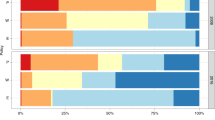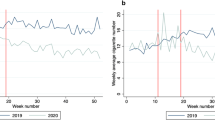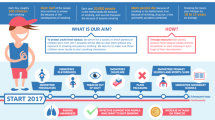Abstract
The removal of all branding and promotions from tobacco products, known as ‘plain packaging’, is intended to decrease tobacco consumption. Here we examine the effectiveness of Australia’s plain packaging law, which coincided with a change in graphic and text health warnings, by using nationally indicative data 5 years post implementation. We measured the effect of the law on smoking prevalence, tobacco expenditure, expenditure intensity and quantity of tobacco consumed, using New Zealand as a control country in a difference-in-differences research design. We uncover a substitution effect that is robust to different specifications and control countries. In response to the policy, smokers switched from more expensive to cheaper cigarettes and reduced their overall tobacco expenditure and expenditure intensity. However, as smoking became less costly, smokers consumed more cigarettes. To discourage such substitution and to help the policy achieve its intended outcomes, policymakers should consider implementing auxiliary measures, such as taxes or price floors.
This is a preview of subscription content, access via your institution
Access options
Access Nature and 54 other Nature Portfolio journals
Get Nature+, our best-value online-access subscription
$29.99 / 30 days
cancel any time
Subscribe to this journal
Receive 12 digital issues and online access to articles
$119.00 per year
only $9.92 per issue
Buy this article
- Purchase on Springer Link
- Instant access to full article PDF
Prices may be subject to local taxes which are calculated during checkout



Similar content being viewed by others
Data availability
The data that support the findings of this study are available from https://data.mendeley.com/datasets/nbjjjz9b4r/1.
Code availability
Code that supports the findings of this study is available from https://data.mendeley.com/datasets/nbjjjz9b4r/1.
Change history
02 October 2020
An amendment to this paper has been published and can be accessed via a link at the top of the paper.
References
Goodchild, M., Nargis, N. & Despaignet, E. T. Global economic cost of smoking-attributable diseases. Tob. Control 27, 58–64 (2017).
Freeman, B., Chapman, S. & Rimmer, M. The case for the plain packaging of tobacco products. Addiction 103, 580–590 (2008).
Cunningham, R. & Kyle, K. The case for plain packaging. Tob. Control 4, 80–86 (1995).
Beede, P. & Lawson, R. The effect of plain packages on the perception of cigarette health warnings. Public Health 106, 315–322 (1992).
Rootman, I., & Flay. B. A study on youth smoking: plain packaging, health warnings, event marketing and price reductions (University of Toronto, 1995).
Hammond, D. et al. Text and graphic warnings on cigarette packages. Am. J. Prev. Med. 32, 202–209 (2007).
Mutti, S. et al. Beyond light and mild: cigarette brand descriptors and perceptions of risk in the international tobacco control (ITC) four country survey. Addiction 106, 1166–1175 (2011).
Wakefield, M., Morley, C., Horan, J. K. & Cummings, K. M. The cigarette pack as image: new evidence from tobacco industry documents. Tob. Control 11, i73–i80 (2002).
Harris, F. et al. Effects of the 2003 advertising/promotion ban in the United Kingdom on awareness of tobacco marketing: findings from the international tobacco control (ITC) four country survey. Tob. Control 15, iii26–iii33 (2006).
Borland, R. et al. How reactions to cigarette packet health warnings influence quitting: findings from the ITC four-country survey. Addiction 104, 669–675 (2009).
Ferraro, R., Bettman, J. & Chartrand, T. The power of strangers: the effect of incidental consumer brand encounters on brand choice. J. Consum. Res. 35, 729–741 (2009).
Wakefield, M., Germain, D. & Durkin, S. How does increasingly plainer cigarette packaging influence adult smokers’ perceptions about brand image? An experimental study. Tob. Control 17, 416–421 (2008).
Germain, D., Wakefield, M. A. & Durkin, S. J. Adolescents perceptions of cigarette brand image: Does plain packaging make a difference? J. Adolesc. Health 46, 385–392 (2010).
Wakefield, M. et al. Australian adult smokers’ responses to plain packaging with larger graphic health warnings 1 year after implementation: results from a national cross-sectional tracking survey. Tob. Control 24, ii17–ii25 (2015).
Brennan, E. et al. Are quitting-related cognitions and behaviours predicted by proximal responses to plain packaging with larger health warnings? Findings from a national cohort study with Australian adult smokers. Tob. Control 24, ii33–ii41 (2015).
Durkin, S. et al. Short-term changes in quitting-related cognitions and behaviours after the implementation of plain packaging with larger health warnings: findings from a national cohort study with Australian adult smokers. Tob. Control 24, ii26–ii32 (2015).
Davidson, S., & de Silva, A. Stubbing out the evidence of tobacco plain packaging efficacy: an analysis of the Australian national tobacco plain packaging survey. SSRN. https://doi.org/10.2139/ssrn.2780938 (2016).
Kaul, A. & Wolf, M. The (possible) effect of plain packaging on the smoking prevalence of minors in Australia: a trend analysis, working paper no. 149 (University of Zurich, Department of Economics, 2014).
Kaul, A. & Wolf, M. The (possible) effect of plain packaging on smoking prevalence in Australia: a trend analysis, working paper no. 165 (University of Zurich, Department of Economics, 2014).
Laverty, A., Watt, H. C., Arnott, D. & Hopkinson, N. S. Standardised packaging and tobacco-industry-funded research. Lancet 383, 1384 (2014).
Diethelm, P. & Farley, T. Refuting tobacco-industry funded research: empirical data shows decline in smoking prevalence following introduction of plain packaging in Australia. Tob. Prev. Cessat. 1, 1–10 (2015).
Benmarhnia, T. et al. A difference-in-differences approach to assess the effect of a heat action plan on heat-related mortality, and differences in effectiveness according to sex, age, and socioeconomic status (Montreal, Quebec). Environ. Health Perspect. 124, 1694–1699 (2016).
Wakefield, M. et al. Time series analysis of the impact of tobacco control policies on smoking prevalence among Australian adults, 2001–2011. Bull. World Health Organ. 92, 413–422 (2014).
Farrelly, M., Pechacek, T. & Chaloupka, F. The impact of tobacco control program expenditures on aggregate cigarette sales: 1981–2000. J. Health Econ. 22, 843–859 (2003).
Lewis, M., Wang, Y., Cahn, Z. & Berg, C. J. An exploratory analysis of cigarette price premium, market share and consumer loyalty in relation to continued consumption versus cessation in a national US panel. BMJ Open 5, e008796 (2015).
Skaczkowski, G., Durkin, S., Kashima, Y. & Wakefield, M. Influence of premium versus value brand names on the smoking experience in a plain packaging environment: an experimental study. BMJ Open 7, e014099 (2016).
Shaw, M. Time for a smoke? One cigarette reduces your life by 11 minutes. BMJ 320, 53 (2000).
Rigotti, N. A., Regan, S., Majchrzak, N. E., Knight, J. R. & Wechsler, H. Tobacco use by Massachusetts public college students: long term effect of the Massachusetts tobacco control program. Tob. Control 2, ii20–ii24 (2002).
Abadie, A., Diamond, A. & Hainmueller, J. Synthetic control methods for comparative case studies: estimating the effect of California’s tobacco control program. J. Am. Stat. Assoc. 105, 493–505 (2010).
Callison, K. & Kaestner, R. Do higher tobacco taxes reduce adult smoking? New evidence of the effect of recent cigarette tax increases on adult smoking. Econ. Inq. 52, 155–172 (2014).
Basu, S., Meghani, A. & Siddiqi, A. Evaluating the health impact of large-scale public policy changes: classical and novel approaches. Annu. Rev. Public Health 38, 351–370 (2017).
Zhu, B., Giovino, G., Mowery, P. & Eriksen, M. The relationship between cigarette smoking and education revisited: implications for categorizing persons’ educational status. Am. J. Public Health 86, 1582–1589 (1996).
Paraje, G. & Araya, D. Relationship between smoking and health and education spending in Chile. Tob. Control 27, 560–567 (2018).
Levy, D. T., Chaloupka, F. & Gitchell, J. The effects of tobacco control policies on smoking rates: a tobacco control scorecard. J. Public Health Manag. Pract. 10, 338–353 (2004).
Baluja, K., Park, J. & Myers, D. Inclusion of immigrant status in smoking prevalence statistics. Am. J. Public Health 93, 642–646 (2003).
Baum, C. F., Schaffer, M. E. & Stillman, S. IVREG22: Stata module for extended instrumental variables/2SLS and GMM estimation. Statistical Software Components S425401. https://ideas.repec.org/c/boc/bocode/s425401.html (Boston College Department of Economics, 2007).
Abadie, A., Diamond, A. & Hainmueller, J. SYNTH: Stata module to implement synthetic control methods for comparative case studies. Statistical Software Components S457334. https://ideas.repec.org/c/boc/bocode/s457334.html (Boston College Department of Economics, 2011).
Acknowledgements
The authors received no specific funding for this work.
Author information
Authors and Affiliations
Contributions
D.U., S.S. and R.A.M.H.M.W. designed the study. D.U. collected the data and conducted statistical analysis. S.S. conducted part of the robustness check. D.U. drafted the initial manuscript. S.S. and R.A.M.H.M.W. revised the manuscript.
Corresponding author
Ethics declarations
Competing interests
The authors declare no competing interests.
Additional information
Peer review information Primary handling editor: Stavroula Kousta.
Publisher’s note Springer Nature remains neutral with regard to jurisdictional claims in published maps and institutional affiliations.
Supplementary information
Supplementary Information
Supplementary Tables 1-4 and Supplementary Figure 1
Rights and permissions
About this article
Cite this article
Underwood, D., Sun, S. & Welters, R.A.M.H.M. The effectiveness of plain packaging in discouraging tobacco consumption in Australia. Nat Hum Behav 4, 1273–1284 (2020). https://doi.org/10.1038/s41562-020-00940-6
Received:
Accepted:
Published:
Issue Date:
DOI: https://doi.org/10.1038/s41562-020-00940-6



